Cheese Flan Recipe
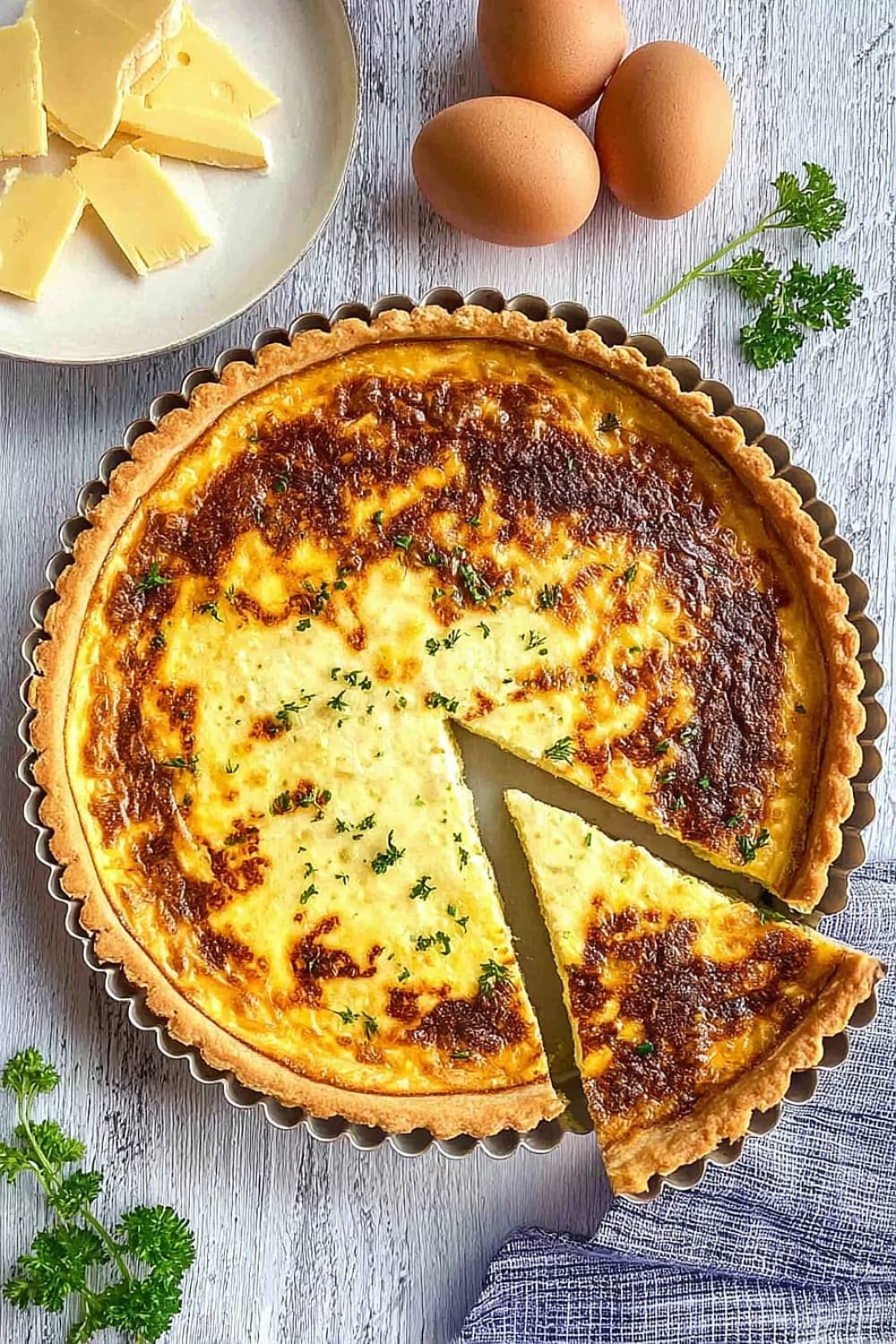
This cheese flan is basically the sophisticated cousin of quiche who went to culinary school but still knows how to have a good time.

Picture a crispy, buttery pastry base loaded with sharp cheddar that cradles a silky, custard-like filling that’s pure comfort food magic.
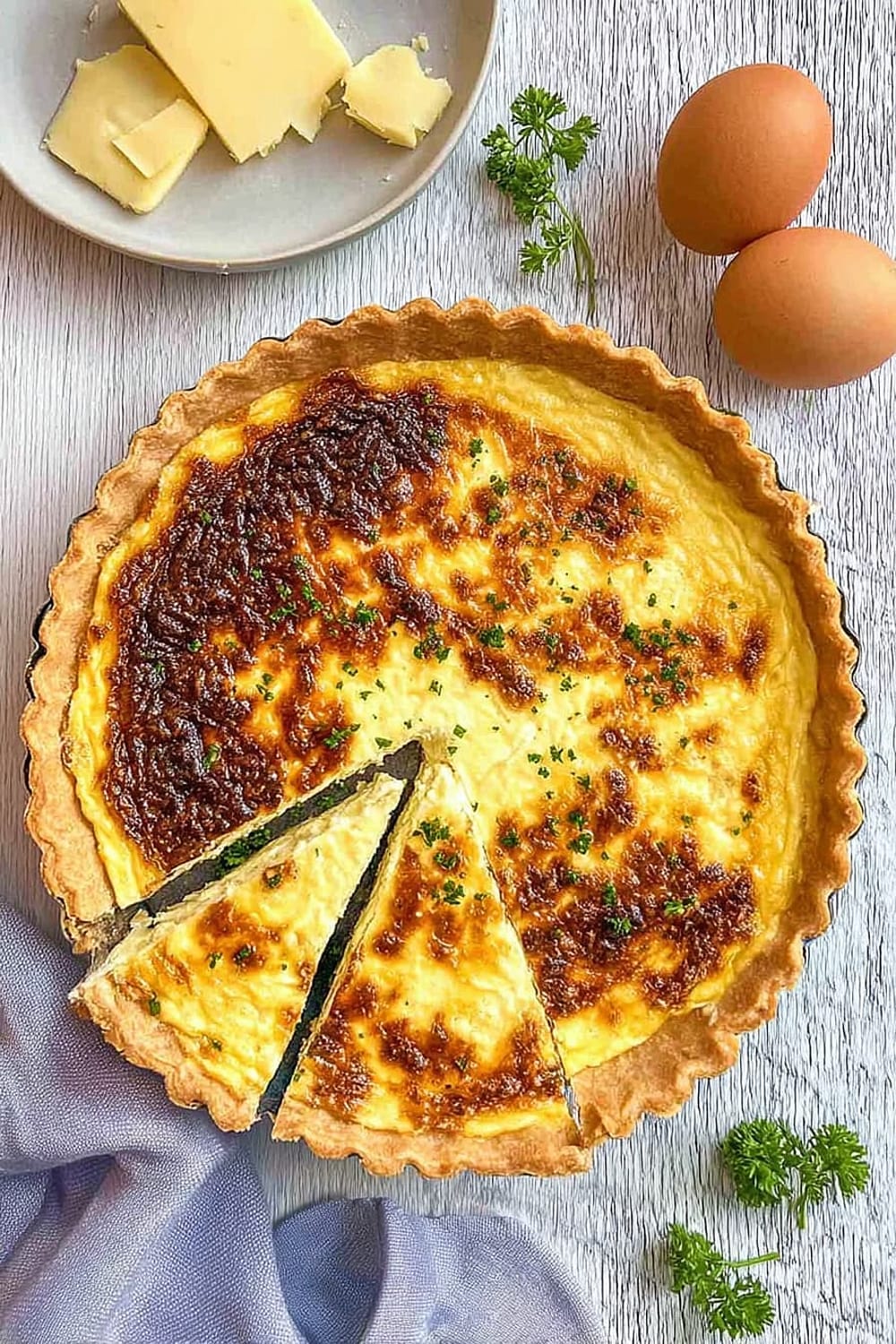
The beauty of this recipe lies in its simplicity – while quiche can be fussy with blind baking and temperamental fillings, this flan comes together with minimal drama and maximum flavor payoff.
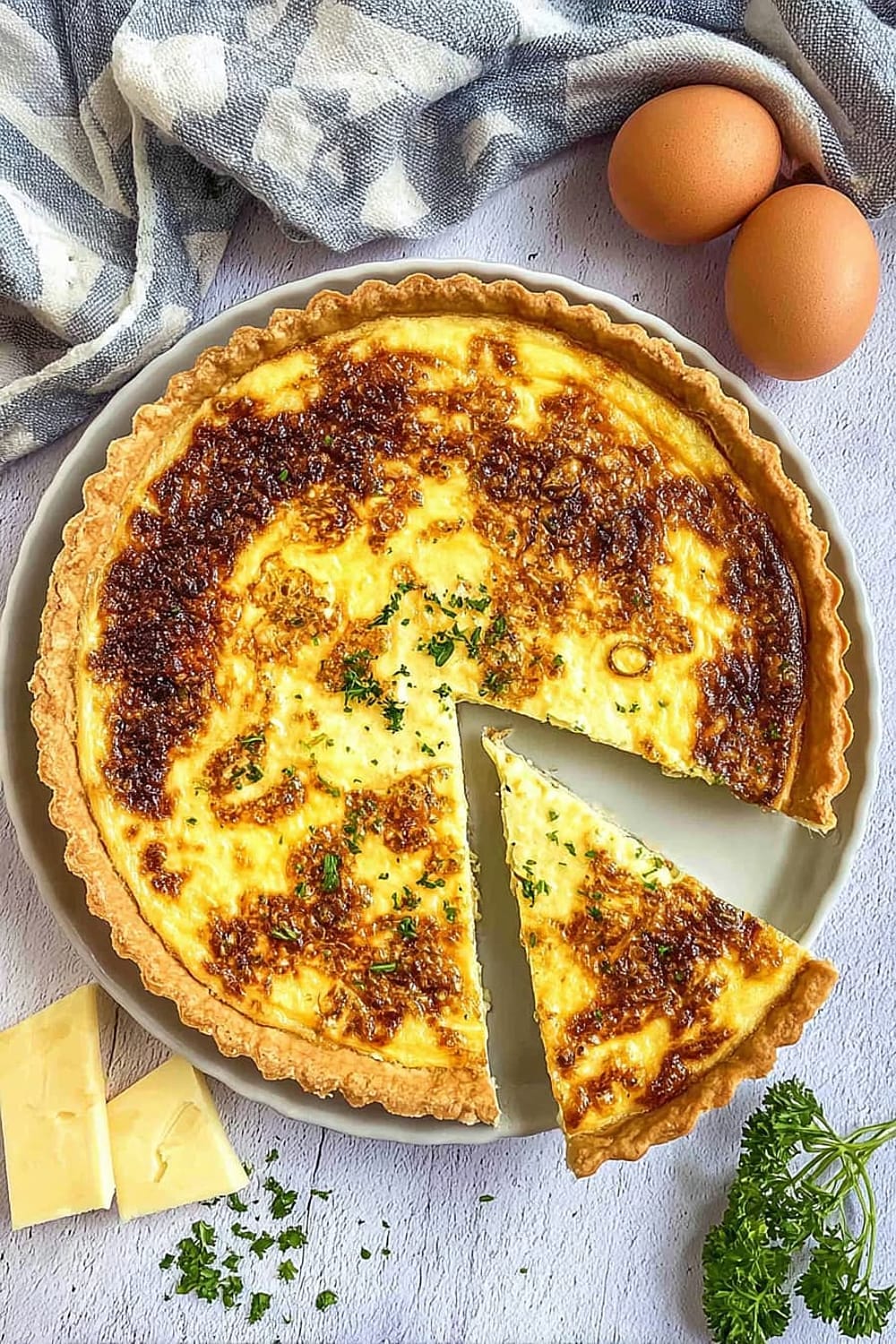
You’ll get that perfect contrast between the flaky, cheese-studded pastry and the creamy, savory custard that sets to golden perfection in your oven.
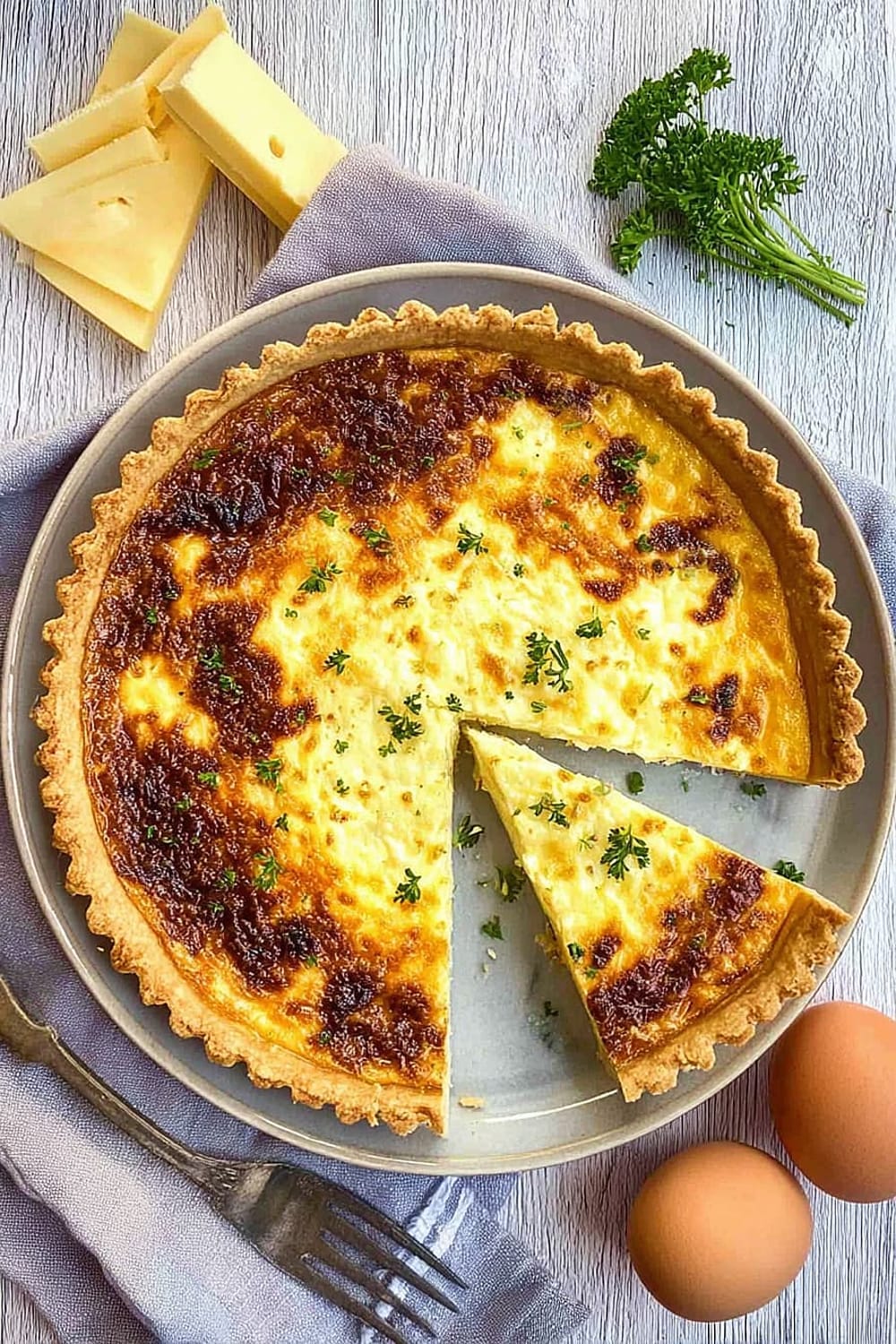
This is the kind of dish that makes people assume you’re a much better cook than you actually are, and honestly, we’re not going to correct them.
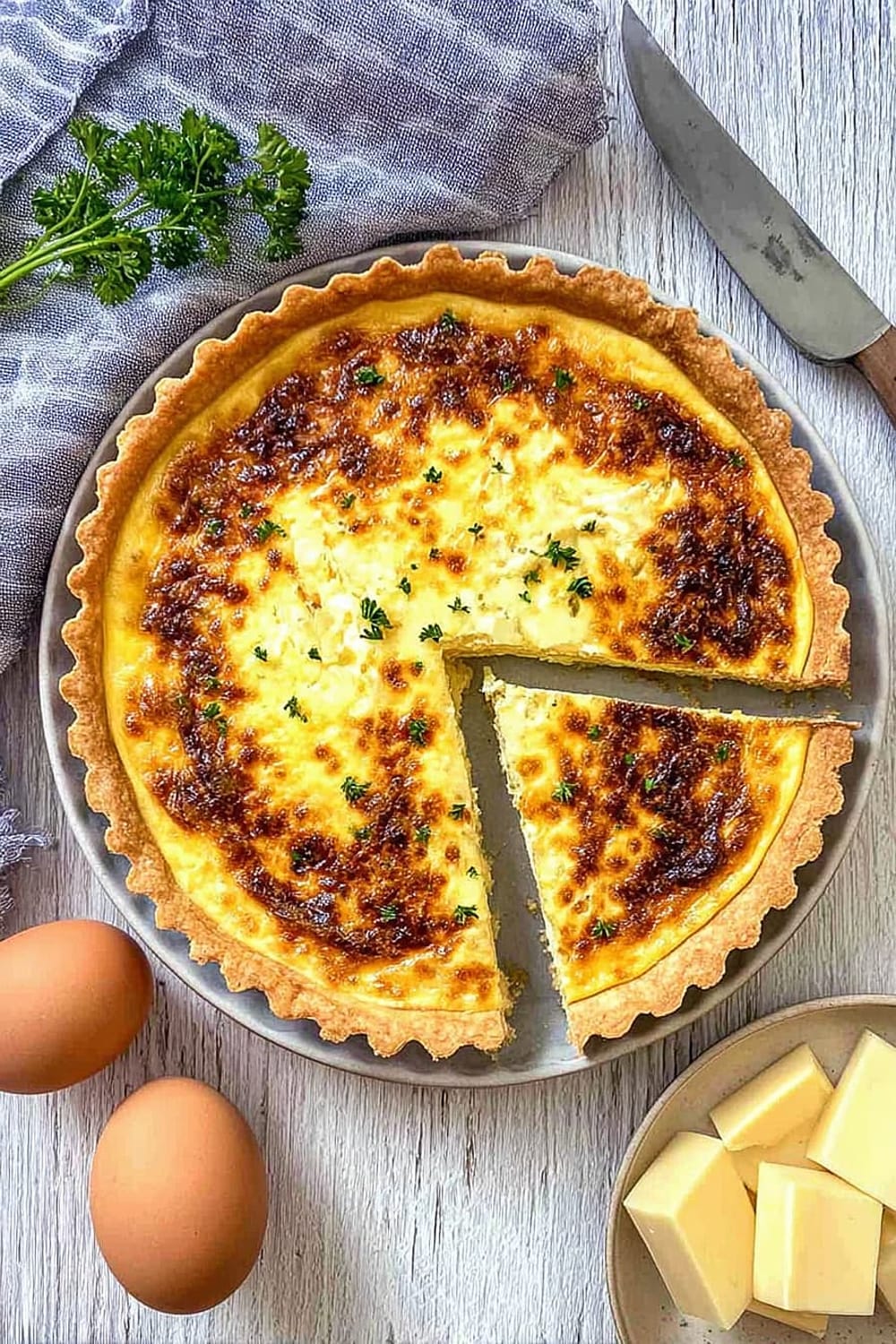
Whether you’re serving it warm from the oven for a cozy lunch or at room temperature for an elegant brunch spread, this cheese flan delivers restaurant-quality results with home cook ease.
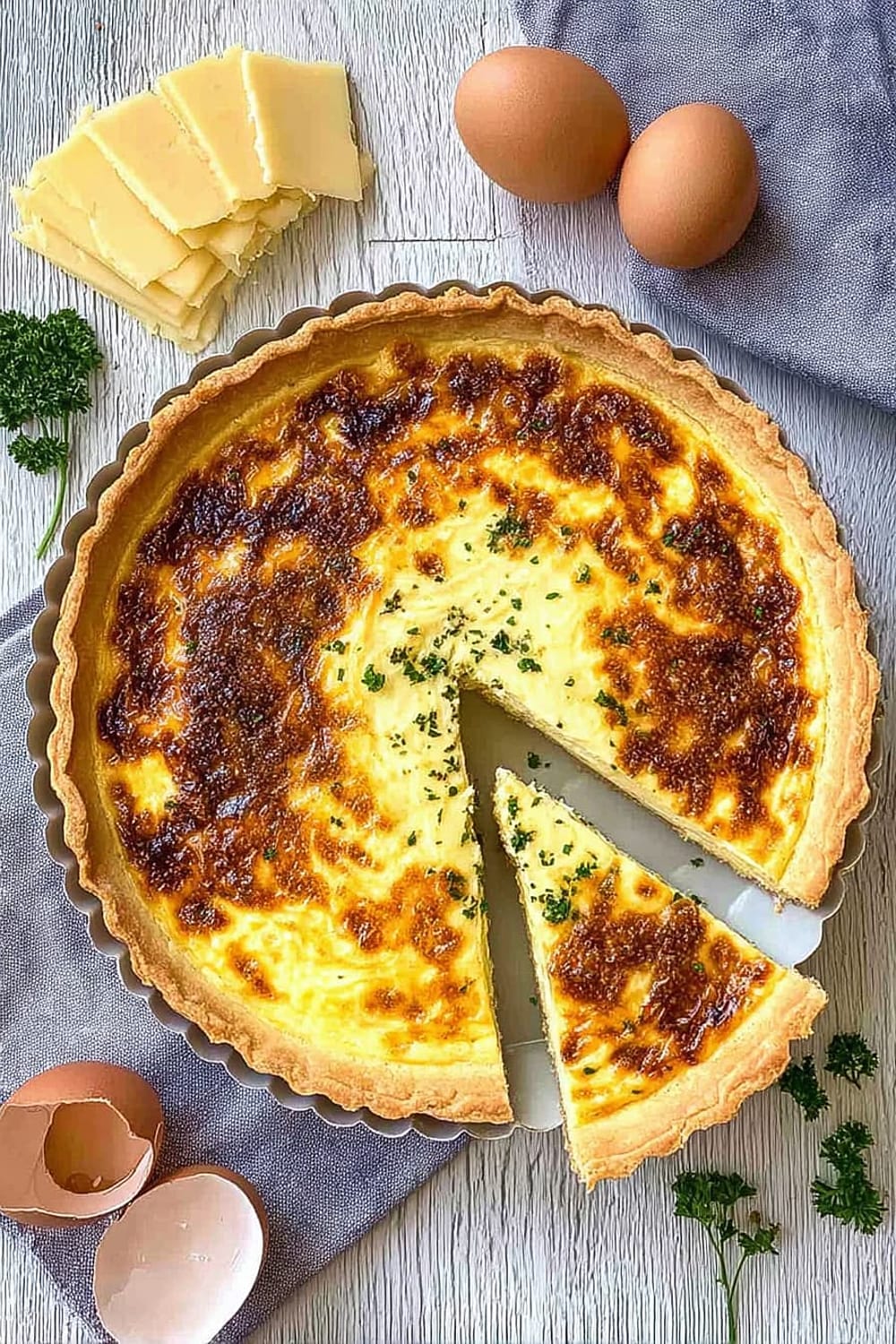
Ingredients
For the Pastry
- 115 g plain flour (organic recommended)
- 70 g butter (organic, cold and cubed)
- 0 .5 egg (beaten – whisk whole eggs and measure)
- 60 g mature cheddar cheese (grated)
For the Filling
- 115 g mature cheddar cheese (grated, organic)
- 280 ml milk (semi-skimmed or full fat, organic)
- 1 .5 eggs (free-range, organic)
Instructions
Prepare the Pastry (Food Processor Method)
- 1 Sieve 115g plain flour into your food processor bowl, then add 70g cold butter (cubed), 0.5 beaten egg, and 60g grated mature cheddar. The key here is keeping that butter cold – it creates those lovely flaky layers in your pastry base.
- 2 Pulse the mixture for just a few seconds until the pastry comes together into a cohesive dough. Don’t overwork it, or you’ll end up with tough pastry instead of that tender, flaky texture we’re after.
- 3 Wrap the pastry dough in beeswax wrap or clingfilm to prevent air exposure and place in the fridge for 30 minutes. This resting time allows the gluten to relax and makes rolling much easier.
Alternative Manual Method
- 4 If you prefer the traditional approach, sieve 115g plain flour into a large mixing bowl and rub in 70g cold butter using your fingertips until the mixture resembles fine breadcrumbs. This technique takes patience but gives you complete control over the texture.
- 5 Gradually add 0.5 beaten egg and bring the mixture together until it forms a soft dough, adding a tiny amount of cold water if needed. Knead in 60g grated cheddar until evenly distributed, then wrap and chill for 30 minutes.
Assemble and Bake the Flan
- 6 Preheat your oven to 230°C (450°F/Gas 8) and dust your work surface with a light coating of flour. Roll out the chilled pastry to ½cm thickness in a roughly circular shape, turning it 90 degrees occasionally to maintain even thickness.
- 7 Roll the pastry loosely around your rolling pin and carefully unroll it over a 23cm (9-inch) flan dish. This technique prevents tearing and ensures even coverage.
- 8 Gently press the pastry into the tin, making sure it fits snugly into the corners without stretching. Use a rolling pin to roll over the edges of the flan dish to trim excess pastry – save those scraps for cheese biscuits later.
- 9 Sprinkle 115g grated mature cheddar evenly over the pastry base, creating a generous cheese layer that will meld beautifully with the custard filling.
- 10 In a mixing bowl, whisk 1.5 eggs until smooth, then gradually mix in 280ml milk until completely combined. This custard base should be silky and lump-free.
- 11 Pour the egg and milk mixture carefully over the cheese, ensuring even distribution without disturbing the pastry edges.
- 12 Place the flan on the middle shelf of your preheated oven and bake for 12 minutes until the filling just begins to set. You’ll notice a slight skin forming on top – this is exactly what you want.
- 13 Reduce the oven temperature to 200°C (400°F/Gas 6) and continue cooking for 15-20 minutes until the filling is completely set but still has a slight wobble in the center when gently shaken.
- 14 Remove from the oven and allow to cool for at least 10 minutes before serving. This cooling time lets the custard finish setting and makes slicing much cleaner.
Recommended Equipment and Kitchen Tools
Recommended Tools (for best results)
- Food processor – Makes pastry preparation incredibly quick and ensures perfect butter distribution without overworking the dough
- 23cm (9-inch) flan dish – The ideal size for this recipe; ceramic or metal both work beautifully and conduct heat evenly
- Rolling pin – Essential for achieving that perfect ½cm pastry thickness and professional-looking results
- Fine mesh sieve – Ensures lump-free flour and creates a smoother pastry texture
Helpful Upgrades
- Kitchen scale – Precision matters in pastry making, and weighing ingredients gives consistently better results than volume measurements
- Pastry brush – Perfect for applying egg wash if you want to add extra golden color to your pastry edges
- Bench scraper – Makes transferring rolled pastry and cleaning your work surface effortless
Nice-to-Have Options
- Silicone spatula – Ideal for scraping every bit of custard mixture from your bowl without waste
- Mixing bowls in various sizes – Having the right size bowl makes whisking eggs and combining ingredients much more efficient
Recipe Variations and Dietary Modifications
Gluten-Free Adaptation
- Replace 115g plain flour with a 1:1 gluten-free flour blend that contains xanthan gum
- Add an extra 1 tablespoon of cold butter to compensate for texture differences
- Expect a slightly more crumbly pastry that’s still absolutely delicious
- Chill the pastry for 45 minutes instead of 30 for easier handling
Dairy-Free Modifications
- Substitute butter with 70g cold vegan butter or solid coconut oil
- Replace 280ml milk with unsweetened oat milk or cashew milk for creaminess
- Use dairy-free cheese alternatives, though the flavor will be milder
- Consider adding nutritional yeast for extra savory depth
Flavor Variations
- Herb-infused version: Add 2 tablespoons fresh chives, thyme, or rosemary to the filling
- Bacon and cheese: Incorporate 100g crispy bacon pieces with the cheese layer
- Caramelized onion: Fold in 150g slow-cooked caramelized onions for sweetness
- Blue cheese twist: Replace half the cheddar with crumbled blue cheese for sophisticated flavor
- Seasonal vegetable: Add 100g blanched asparagus, spinach, or roasted peppers
Spice Enhancement
- Mustard powder: Add 1 teaspoon to the pastry for subtle heat
- Paprika: Sprinkle ½ teaspoon over the cheese before adding custard
- Black pepper: Freshly cracked pepper elevates the entire flavor profile
Nutritional Information and Health Benefits
Key Nutritional Highlights
This cheese flan provides approximately 277 calories per serving when cut into 6 portions, making it a satisfying yet reasonable meal option. The combination of eggs, milk, and cheese delivers high-quality complete proteins containing all essential amino acids your body needs for muscle maintenance and repair. Each serving provides significant calcium from the dairy components, supporting bone health and proper muscle function.
Health Benefits of Main Ingredients
The free-range eggs in this recipe are nutritional powerhouses, providing vitamin B12 for nervous system health, choline for brain function, and lutein for eye health. Mature cheddar cheese contributes not only calcium but also vitamin K2, which works synergistically with calcium for optimal bone health. The organic milk adds riboflavin and phosphorus while providing a creamy base that’s easier to digest than many processed alternatives. Organic flour retains more nutrients than heavily processed versions and provides B vitamins and fiber.
Dietary Considerations
This recipe contains gluten, dairy, and eggs, making it unsuitable for those with celiac disease, lactose intolerance, or egg allergies without modifications. However, it fits well into vegetarian meal plans and provides substantial protein for those following Mediterranean-style eating patterns. The moderate calorie content makes it appropriate for balanced weight management when paired with vegetables or salad.
Smart Swaps and Ingredient Substitutions
Common Substitutions:
- Plain flour → Substitute with 115g self-raising flour minus 1 teaspoon (reduces baking powder content)
- Mature cheddar → Gruyere, aged gouda, or sharp white cheddar work beautifully with similar melting properties
- Whole milk → Half-and-half for extra richness, or 2% milk for lighter results
- Butter → Lard or vegetable shortening for different pastry texture (use same amount)
Budget-Friendly Swaps:
- Organic ingredients → Standard versions work perfectly fine and significantly reduce cost
- Mature cheddar → Medium cheddar plus ½ teaspoon mustard powder for enhanced flavor
- Free-range eggs → Standard eggs provide identical cooking results
Pantry Emergency Substitutions:
- Fresh milk → Powdered milk reconstituted (mix 85g powder with 280ml water)
- Cheddar cheese → Any hard cheese you have on hand – even parmesan creates delicious results
- Plain flour → All-purpose flour (exact same ingredient in different regions)
Pro Tips for Substitutions:
- Store grated cheese in freezer for up to 3 months – grate straight from frozen
- Room temperature eggs mix more easily – place cold eggs in warm water for 5 minutes
- European butter has higher fat content and creates flakier pastry
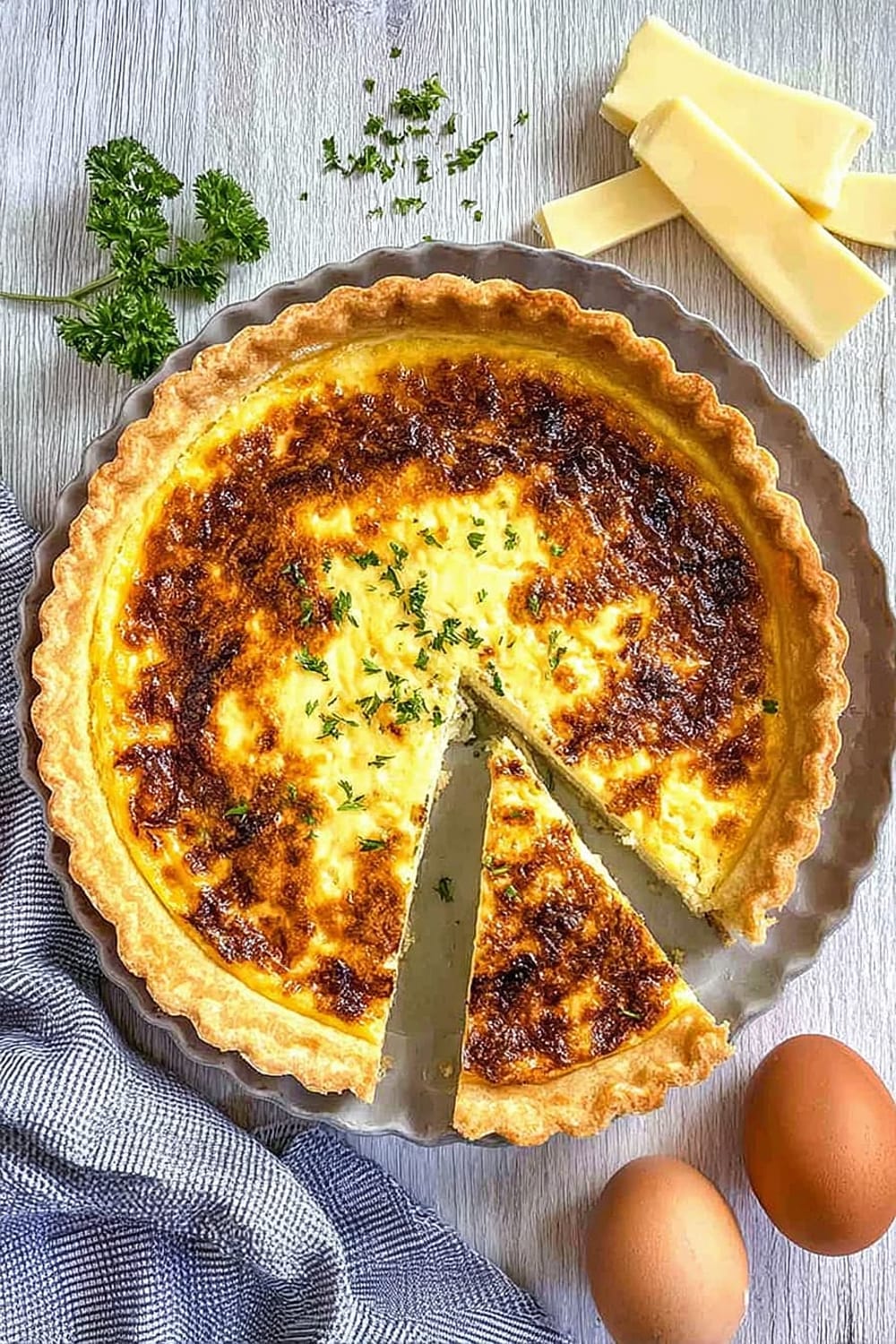
Make It Diabetes-Friendly
Flour & Carb Modifications:
- Replace 115g plain flour with 85g almond flour plus 30g coconut flour for significant carb reduction
- This substitution reduces carbohydrates from approximately 19g per serving to 8g per serving
- Add 1 extra tablespoon of cold butter to compensate for different binding properties
- Expect a nuttier flavor and slightly denser texture that’s still absolutely delicious
Milk Adjustments:
- Substitute 280ml whole milk with 280ml unsweetened almond milk to reduce carbs by 4g per serving
- Heavy cream diluted 1:1 with water provides richness with fewer carbs than milk
- Consider 240ml milk plus 40ml heavy cream for creaminess with moderate carb reduction
Portion & Timing Tips:
- Cut into 8 smaller servings instead of 6 for better blood sugar management
- Serve with mixed green salad or roasted vegetables to add fiber and slow digestion
- Pair with 2-3 oz lean protein to further stabilize blood sugar response
- Best consumed earlier in the day when insulin sensitivity is typically higher
Total Carb Reduction: These modifications reduce carbohydrates from 19g to approximately 12g per serving while maintaining the essential character of this beloved cheese flan.
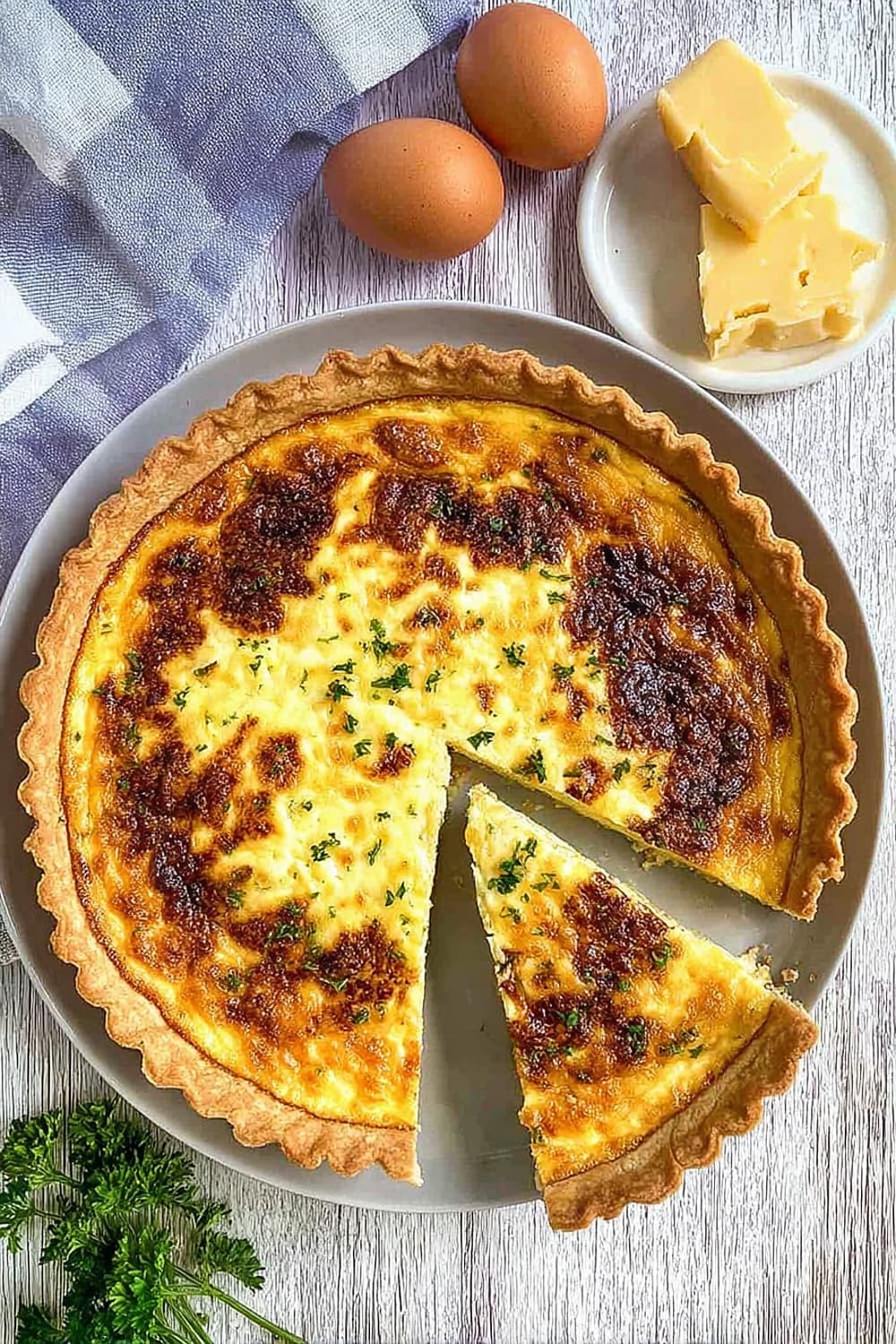
Perfect Pairing Suggestions
Beverage Pairings
A crisp Sauvignon Blanc or Pinot Grigio complements the rich cheese flavors without overwhelming the delicate custard, while a light Chardonnay enhances the buttery pastry notes. For beer lovers, a wheat beer or light ale provides refreshing contrast to the creamy texture. Sparkling water with lemon or iced green tea offer excellent non-alcoholic options that cleanse the palate between bites.
Side Dish Recommendations
This cheese flan shines alongside a crisp mixed greens salad with vinaigrette dressing that cuts through the richness beautifully. Roasted cherry tomatoes with fresh basil add bright acidity and seasonal freshness, while steamed asparagus or blanched green beans provide textural contrast and nutritional balance. Crusty artisan bread or herb-roasted potatoes transform this into a more substantial meal.
Complete Meal Ideas
For elegant brunch entertaining, serve warm wedges with smoked salmon, fresh fruit salad, and croissants. As a light dinner, pair with soup (tomato basil or butternut squash work wonderfully) and crusty bread. For casual lunch, serve at room temperature with Mediterranean olives, sliced cucumbers, and whole grain crackers.
Occasion Suggestions
This versatile flan excels at weekend brunches, picnic spreads (travels beautifully), light summer dinners, and casual entertaining. It’s particularly perfect for spring gatherings when you want something satisfying but not too heavy, and makes an excellent make-ahead option for busy hosts.
Pro Tips and Troubleshooting
Professional Secrets
Keep your butter ice-cold until the moment you use it – this creates those coveted flaky pastry layers that separate good flan from exceptional flan. When rolling pastry, work quickly and dust your surface lightly but frequently to prevent sticking without incorporating excess flour. Room temperature eggs incorporate more smoothly into the custard, so remove them from the fridge 30 minutes before cooking.
Common Mistake Prevention
Avoid overmixing your pastry – pulse just until it comes together, then stop immediately. Overworked pastry becomes tough and shrinks during baking. Don’t skip the 30-minute chilling time; rushed pastry is difficult to handle and often shrinks. When pouring the custard, pour slowly and steadily to avoid creating air bubbles that can cause uneven setting.
Storage and Reheating
Store covered in the refrigerator for up to 3 days. This flan actually improves in flavor after the first day as the flavors meld together. Reheat individual slices in a 300°F (150°C) oven for 8-10 minutes to restore the pastry’s crispness, or enjoy cold – it’s delicious both ways. Avoid microwaving as it makes the pastry soggy.
Make-Ahead Strategy
Prepare the pastry up to 2 days ahead and keep wrapped in the refrigerator. The assembled unbaked flan can be covered and refrigerated for up to 4 hours before baking. For entertaining, bake in the morning and serve at room temperature – the flavors are actually more pronounced when not piping hot.
This cheese flan proves that sometimes the most satisfying dishes are the ones that don’t try too hard – just honest, delicious flavors executed with care and attention to detail.